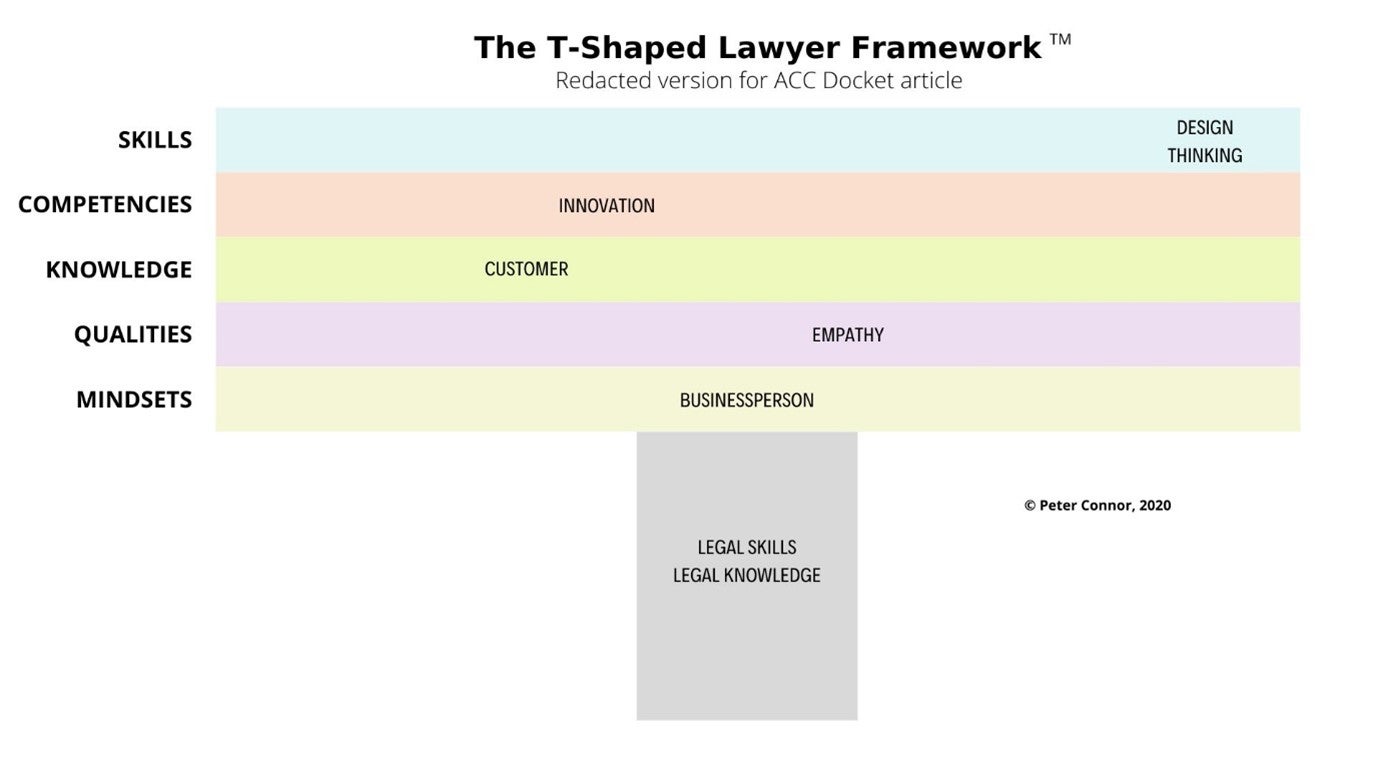Banner artwork by Gannvector / Shutterstock.com
Previous articles in this series (Part 1, Part 2) highlighted the necessity of a new vision for your work of Law + Business that will address many of your concerns and aspirations and will maximize the value you provide to your organizations. Embrace becoming a T-Shaped Lawyer — a versatile professional offering both legal and business advice and work, and serving broader business interests, not merely the legal department.
The right initial questions to ask yourself
Whether you agree with that vision or not, the right questions to start with include:
- What can I change? (The answer, by the way, is yourself and your work!)
- Why would I change myself and my work and what do I aim to achieve by changing?
- What changes do I need to make to myself and my work? Can I achieve that objective on my current path, or do I need a new direction such as suggested above?
Why is it so important to consider these questions first? Everyone knows that legal skills and knowledge are no longer sufficient for a successful and fulfilling career, and now everyone is asking, or opining on, what new skills are necessary. What’s wrong with doing that?
The problem with trying to select skills first
First, how can you decide what new skills and capabilities you will need unless and until you consider how you plan to use them? Without thinking about what changes you will make to your work, the default will be no change. Non-legal skills may help you do legal work to some extent. However, the main benefit of, and reason to develop, non-legal skills is so that you can do non-legal work — in other words, business work as explained in the last article. To put it in simple terms, you need to clarify “the why” and “the what” before you consider “the how.”
Secondly, “the how” to become a T-Shaped Lawyer, or to attain any other vision, involves a lot more than just skills. Also, the selection of what is required should be aligned to that vision and not based on some random selection.
The T-Shaped Lawyer Framework™
For example, I have developed the T-Shaped Lawyer Framework™ that provides a structured approach to professional development to help lawyers realize the T-Shaped Lawyer vision. I am not able to share with you the whole framework until I publish my second book later this year. However, below is a redacted version to illustrate some key points.

The initial framework is based on what helped me to be a T-Shaped Lawyer, and it has since been refined in workshops and in the process of rolling it out as the basis for professional development programs for over a thousand lawyers in many different countries.
Understanding the Framework components
As you can see, the Framework distinguishes between different “horizontal” categories of skills, competencies, knowledge, qualities, and mindsets. Each of these categories are essential, but component areas of one category are developed and used in different ways from those in another category. For example:
- Mindsets like The Businessperson Mindset™ should be adopted right away. Without that mindset, you might not identify an opportunity to use a skill like Design Thinking for the business.
- Skills like design thinking can be learned to a basic level quite quickly and, over time, can be used just for legal work — such as simplifying contract terms. However, it can, and should, also be used by lawyers for business work such as helping to solve complex business problems.
- Qualities like empathy can only be enhanced over time, and become particularly useful when used together with a skill such as design thinking.
- Acquiring knowledge of your client, or as I prefer to call, it your “customer,” takes time. It is useful for your legal work, but it becomes essential to do business work, and to develop and utilize a competency like innovation for the business and not just the legal department.
The third reason why it is preferable to develop a “frame of reference” — especially if you are looking to change — before you try to identify or learn new skills is based on the theory of Transformative Learning. According to that theory, espoused by Jack Mezirow and many others, adults learn more effectively when the learning has meaning and a specific purpose. A new frame of reference, such as the T-Shaped Lawyer vision and Framework, provides this purpose. The 10 steps of that theory map perfectly with the steps involved in determining the T-Shaped Lawyer “why,” “what,” and “how.”
While recognizing that non-legal skills are now crucial is a positive, hopefully, this article has illustrated that there is a bit more to it than that and that there are some other crucial questions you need to ask yourself first. My second book, The T-Shaped Lawyer Framework, when it is published later this year, will help you to think through those questions. It will explain how to learn and how to utilize some very specific skills and competencies combined with crucial mindsets, qualities, and knowledge to fundamentally change yourself and your work. The Framework and the book can be your travel companion guidebook on your learning and career journey in changing times, when adaptability and diversification is key.
Disclaimer: The information in any resource in this website should not be construed as legal advice or as a legal opinion on specific facts, and should not be considered representing the views of its authors, its sponsors, and/or ACC. These resources are not intended as a definitive statement on the subject addressed. Rather, they are intended to serve as a tool providing practical guidance and references for the busy in-house practitioner and other readers.




